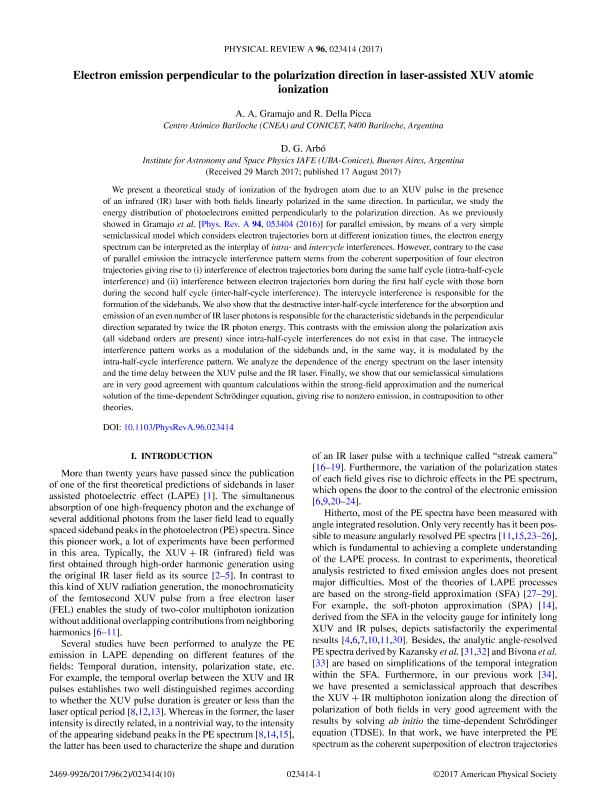Mostrar el registro sencillo del ítem
dc.contributor.author
Gramajo, Ana Alicia

dc.contributor.author
Della Picca, Renata

dc.contributor.author
Arbo, Diego

dc.date.available
2017-12-05T13:56:54Z
dc.date.issued
2017-08
dc.identifier.citation
Gramajo, Ana Alicia; Della Picca, Renata; Arbo, Diego; Electron emission perpendicular to the polarization direction in laser-assisted XUV atomic ionization; American Physical Society; Physical Review A; 96; 2; 8-2017; 023414,1-10
dc.identifier.issn
2469-9926
dc.identifier.uri
http://hdl.handle.net/11336/29687
dc.description.abstract
We present a theoretical study of ionization of the hydrogen atom due to an XUV pulse in the presence of an infrared (IR) laser with both fields linearly polarized in the same direction. In particular, we study the energy distribution of photoelectrons emitted perpendicularly to the polarization direction. As we previously showed in Gramajo et al. [Phys. Rev. A 94, 053404 (2016)1050-294710.1103/PhysRevA.94.053404] for parallel emission, by means of a very simple semiclassical model which considers electron trajectories born at different ionization times, the electron energy spectrum can be interpreted as the interplay of intra- and intercycle interferences. However, contrary to the case of parallel emission the intracycle interference pattern stems from the coherent superposition of four electron trajectories giving rise to (i) interference of electron trajectories born during the same half cycle (intra-half-cycle interference) and (ii) interference between electron trajectories born during the first half cycle with those born during the second half cycle (inter-half-cycle interference). The intercycle interference is responsible for the formation of the sidebands. We also show that the destructive inter-half-cycle interference for the absorption and emission of an even number of IR laser photons is responsible for the characteristic sidebands in the perpendicular direction separated by twice the IR photon energy. This contrasts with the emission along the polarization axis (all sideband orders are present) since intra-half-cycle interferences do not exist in that case. The intracycle interference pattern works as a modulation of the sidebands and, in the same way, it is modulated by the intra-half-cycle interference pattern. We analyze the dependence of the energy spectrum on the laser intensity and the time delay between the XUV pulse and the IR laser. Finally, we show that our semiclassical simulations are in very good agreement with quantum calculations within the strong-field approximation and the numerical solution of the time-dependent Schrödinger equation, giving rise to nonzero emission, in contraposition to other theories.
dc.format
application/pdf
dc.language.iso
eng
dc.publisher
American Physical Society
dc.rights
info:eu-repo/semantics/openAccess
dc.rights.uri
https://creativecommons.org/licenses/by-nc-sa/2.5/ar/
dc.subject
Laser Assisted
dc.subject
Xuv Photoionziation
dc.subject
Intracycle Inferference
dc.subject
Intercycle Interference
dc.subject.classification
Astronomía

dc.subject.classification
Ciencias Físicas

dc.subject.classification
CIENCIAS NATURALES Y EXACTAS

dc.title
Electron emission perpendicular to the polarization direction in laser-assisted XUV atomic ionization
dc.type
info:eu-repo/semantics/article
dc.type
info:ar-repo/semantics/artículo
dc.type
info:eu-repo/semantics/publishedVersion
dc.date.updated
2017-12-04T19:09:35Z
dc.journal.volume
96
dc.journal.number
2
dc.journal.pagination
023414,1-10
dc.journal.pais
Estados Unidos

dc.journal.ciudad
Washington
dc.description.fil
Fil: Gramajo, Ana Alicia. Consejo Nacional de Investigaciones Científicas y Técnicas; Argentina
dc.description.fil
Fil: Della Picca, Renata. Consejo Nacional de Investigaciones Científicas y Técnicas; Argentina
dc.description.fil
Fil: Arbo, Diego. Consejo Nacional de Investigaciónes Científicas y Técnicas. Oficina de Coordinación Administrativa Ciudad Universitaria. Instituto de Astronomía y Física del Espacio. - Universidad de Buenos Aires. Facultad de Ciencias Exactas y Naturales. Instituto de Astronomía y Física del Espacio; Argentina
dc.journal.title
Physical Review A
dc.relation.alternativeid
info:eu-repo/semantics/altIdentifier/url/https://journals.aps.org/pra/abstract/10.1103/PhysRevA.96.023414
dc.relation.alternativeid
info:eu-repo/semantics/altIdentifier/doi/http://dx.doi.org/10.1103/PhysRevA.96.023414
Archivos asociados
